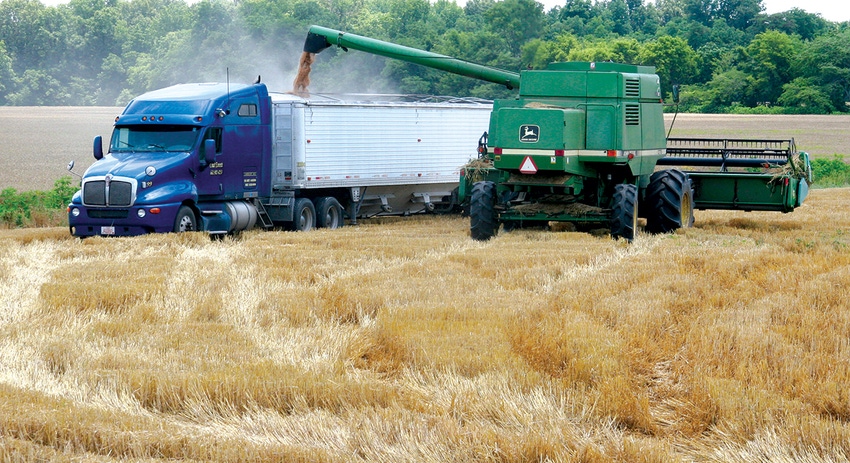
Moving into harvest, the Mid-South wheat crop is shy of historic acreage and high on yield variability.
“Our wheat acreage is extremely low this year – estimated at 50,000 to 60,000 acres,” says Boyd Padgett, LSU AgCenter wheat specialist. “We’re pretty close to completing harvest.
“Unfortunately, I’m hearing of yields all over the board – from 27 bushels per acre to 65 bushels. That’s a very wide range and some growers have cut 70 or 80 bushels. In general, growers are harvesting lower yields than normal with test weights that aren’t where we’d like. Still, this crop is better than (2015’s).”
Scab has been an issue for Louisiana producers this year, “although it has been worse. I’m unaware of any major problems with insect pests. One bright spot: the varietal resistance for rust seems to be doing well.”
Across the river in Mississippi, “we don’t have a very big wheat crop this year,” says Erick Larson, Mississippi State University Extension wheat and corn specialist. “But rainfall keeping Mississippi growers out of the field hasn’t been nearly as big a problem as in Arkansas and Louisiana. The intermittent rainfall we’ve had has slowed things down, though. If there’s been a place in the state where it has been an issue it’s the Delta.”
While Larson has yet to receive many field reports yet, he expects “the crop to be average to, perhaps, slightly above average. A lot depends on where the wheat was planted. Are the soils well-drained? Soils that hold water aren’t likely to see yields better than average.
“Other than some stripe rust we really haven’t had bad disease issues. Our biggest problem historically is rainfall patterns and whether they’re conducive for good yields. We really need dry conditions from late March through early May to optimize production. That wasn’t the case for much of that period this spring.”
In Arkansas, Jason Kelley, Extension grains specialist, says producers are happy with the forecast of a week of sunshine. “After the rains (the first full week of June), harvest should be up and going in a big way starting Wednesday or Thursday. Growers are tired of waiting, ready to get the wheat out and the double-crop beans in.
“It finally looks like the weather will cooperate. The crop is ready to go but rains over the last two weeks have delayed harvest.”
Of the wheat that has been harvested, “I don’t have a good handle on yield expectations. I know some cut in the 60-bushel range yesterday. That isn’t great but I don’t know that we’ve been expecting anything spectacular considering all the rainfall this spring.
“We don’t have a lot of wheat in the state this year. I believe we’ll harvest around 150,000 acres.”
Corn
What about the corn?
“Considering everything corn has been through early-season – cool and wet -- a lot of fields I’ve walked look pretty good,” says Kelley. “All in all, it’s looking better now than it has before. If fields were planted early, they look to be right on schedule with regard to growth stages.
“Obviously the fields that don’t have good drainage have suffered but it has finally warmed up. We have had some growers having trouble getting the last of the nitrogen applied.”
As far as diseases, “there is some common rust, which is normal. We see that every year and it isn’t a huge worry. Southern rust and northern corn leaf blight are much more concerning and, so far, we haven’t found any in the state. Of course, the last couple of weeks have been conducive for disease development so we need to keep a sharp eye out.”
Many Arkansas producers “will be looking to put out an application for southern corn borers. The timing on that will hit mid-June to late June. There’s still a bit of time.”
Mississippi corn acreage will be less than what was originally thought, says Larson. “Grower intentions shifted away from corn to the tune of 15 to 25 percent. That early rainfall that persisted for several months pushed them in that direction.
“We had many more stand issues this year because of the rain. It affected a lot of the different planting windows we had.”
There haven’t been a lot of disease issues in the state’s corn, says Larson. “May weather was largely dry and that led to some folks beginning to irrigate a bit earlier than normal. There are a lot of advantages with having a dry May in terms of crop development and potential yield.
“One of our big limitations is excessively wet, saturated conditions limiting root growth. Dry weather helps stimulate the crop to get much better root growth under the plants. Where we have the ability to apply supplemental irrigation later in the season, yields are normally higher in years when there’s a dry May. It also can be beneficial in terms of seasonal nitrogen availability although the dry weather did cause issues with N fertilizer incorporation, particularly for those who broadcast urea.
“So, we may be set up very well – fingers crossed.”
The most important time for the corn crop is just beginning, says Larson. “Some of the corn is tasseling. From now through July 10 will mostly determine what our yield potential will be. Bring on the cool nights, sunshiny days and a 1.5-inch rain every week or 10 days. That would sustain the dryland crop and help naturally replenish the soil profile for irrigated acres.”
About the Author(s)
You May Also Like




